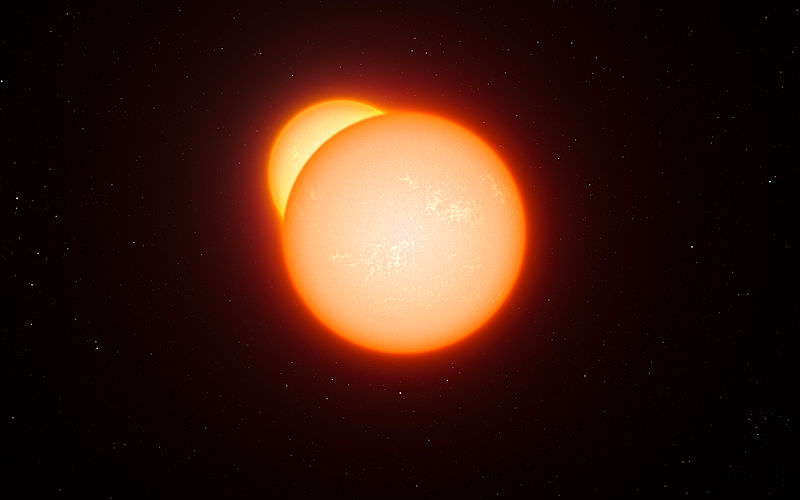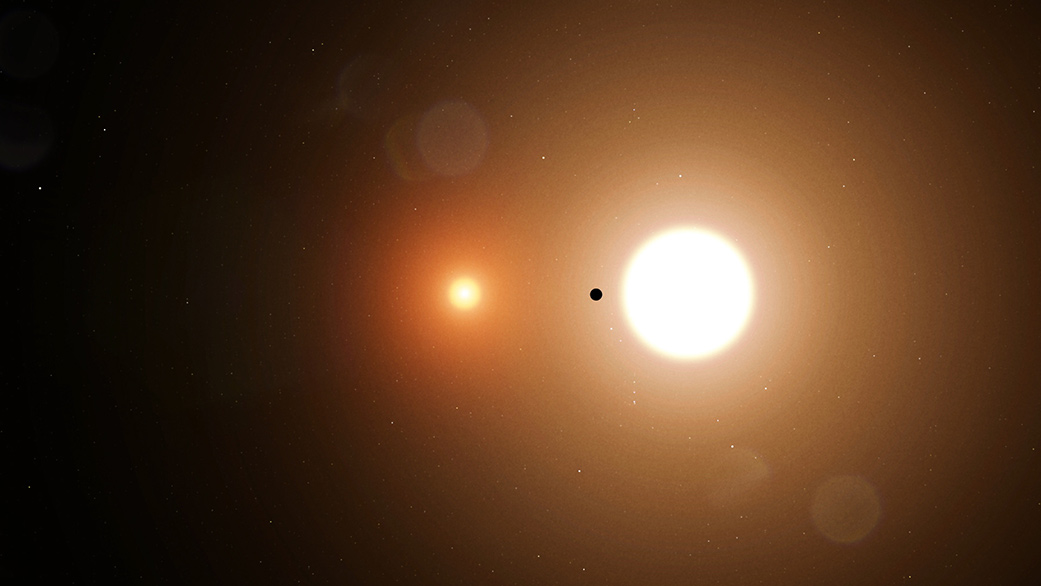In the past few decades, the study of extrasolar planets has grown by leaps and bounds, with the confirmation of over 4000 exoplanets. With so many planets available for study, the focus of exoplanet-researchers is shifting from discovery to characterization. In the coming years, new technologies and next-generation telescopes will also enable Direct Imaging studies, which will vastly improve our understanding of exoplanet atmospheres.
To facilitate this process, astronomers will rely on costly technologies like coronagraphs and starshades, which block out the light of a star so any planets orbiting it will become more visible. However, according to a new study by an international team of astronomers and cosmologists, eclipsing binary stars could provide all the shading that’s needed to directly image planets orbiting them.
The study, which recently appeared online, was led by Stefano Bellotti, a Ph.D. student at the L’Institut de Recherche en Astrophysique et Planétologie (IRAP) at the University of Toulouse. He was joined by researchers from the Centre National de la Recherche Scientifique (CNRS), the Steward Observatory, the National Astronomical Observatory of Japan (NAOJ), and NASA’s Ames Research Center.
As the name would suggest, the Direct Imaging method consists of studying planets directly by analyzing light reflected from their surfaces and/or atmospheres. This method is rather lucrative when it comes to exoplanet studies since it allows astronomers to obtain spectra directly from a planet’s atmosphere, thus revealing its chemical composition and whether or not it could be habitable.
These and other benefits were spelled out by Bellotti who spoke to Universe Today via email. As he put it:
“First of all, this method gives you a reliable ‘yes’ or ‘no’ answer: the planet (or planets) is there or it is not. Furthermore, because this method allows us to directly collect the light coming from a planet, we can directly examine the chemical composition of its atmosphere and have an idea of its features (clouds). Ultimately, this information enables us to assess the habitability of the planet, which is the current main focus of exoplanetary sciences.”
However, this method presents a number of challenges since starlight is likely to be a billion times brighter than any light reflected from its planets. Scientists are able to reduce this discrepancy by an order of magnitude (where the stars appear 1 million times brighter) by examining reflected light in the infrared spectrum.
Because of these limitations, only 50 planets have been discovered using the Direct Imaging method to date. For the most part, these planets have been gas giants that have wide orbits around their stars. Astronomers anticipate that next-generation telescopes that rely on adaptive optics, coronagraphs, or an even an orbiting spacecraft (like NASA’s proposed Starshade), will be able to image smaller, rocky planets that orbit closer to their planets.

For the sake of their study, however, Bellotti and his colleagues examined the potential for eclipsing binaries to do the same job, but without any of the expensive tools involved. As the name suggests, eclipsing binary systems consist of two stars that periodically pass in front of each other relative to the observer. When this happens, the brightness of one star in the system is temporarily blocked out, leading to a reduction in luminosity.
By using eclipsing binaries, explained Bellotti, astronomers can take advantage of the fact that the stellar system already undergoes periodic dimming – which is predictable and can be timed accurately.
“In this sense, the eclipse event suppresses the starlight coming from the binary in a natural way, and therefore results in an enhanced contrast between the binary and a potential planet. However, the eclipse event is not considered as a substitute of coronagraphs or artificial starshades, but it can be thought [of] as an additional tool to use along with them in order to achieve improved contrast levels. Indeed, because during [an] eclipse the binary system becomes point-like as a single star, techniques such as coronagraphy can be applied to block the light of the whole binary in one shot.”
To test this, the team selected eclipsing binaries from several star catalogs whose luminosity drops by a factor of 10 during an eclipse. They also differentiated between types of exoplanets based on whether they emit their own light – aka. self-luminous (SL) – or reflect light (RL). They then simulated how bright orbiting planets would appear based on their mass, and whether or not they’d be visible using current or future telescopes.

“Around two targets, [U Cephei] and [AC Scuti] respectively, we are [sensitive] to planets of roughly 4.5 Jupiter masses and 9 Jupiter masses with current ground- or near-future space-based instruments, and roughly 1.5 Jupiter masses and 6 Jupiter masses with future ground-based observatories (such as [the Extremely Large Telescope (ELT)],” said Bellotti.
For reflected light planets, they selected three eclipsing binaries that were closest to Earth: V1412 Aquilae, RR Caeli, and RT Pictoris. For these systems, they used Jupiter, Venus, and Earth as templates for any possible exoplanets. Here too, they obtained some positive results.
“We concluded that a Jupiter-like planet at a planet-star separation of 20 [milli arcseconds] might be imaged with future ground- and space-based technologies around all three targets,” Bellotti added. “A Venus-like planet at the same separation might be detectable around RR Cae and RT Pic, but a habitable Earth-like planet is challenging, as the planet-star separation is too small compared to the angular separation limit of modern coronagraphy.”
In the coming years, ground-based observatories like the Extremely Large Telescope (ELT), the Thirty Meter Telescope (TMT), and the Giant Magellan Telescope (GMT) are expected to enable direct imaging studies of Earth-like exoplanets. Similarly, the James Webb Space Telescope (JWST) and Nancy Grace Roman Space Telescope (RST) will have cutting-edge infrared instruments that will also be able to study exoplanet atmospheres directly.
While these next-generation telescopes will have a better shot at observing exoplanets directly, it is encouraging to know that less-advanced observatories could still conduct direct imaging studies where eclipsing binaries are concerned. What’s more, these star systems could provide opportunities for advanced telescopes as well since they will be able to get a better look at exoplanets when their stars are eclipsed.
Further Reading: arXiv

